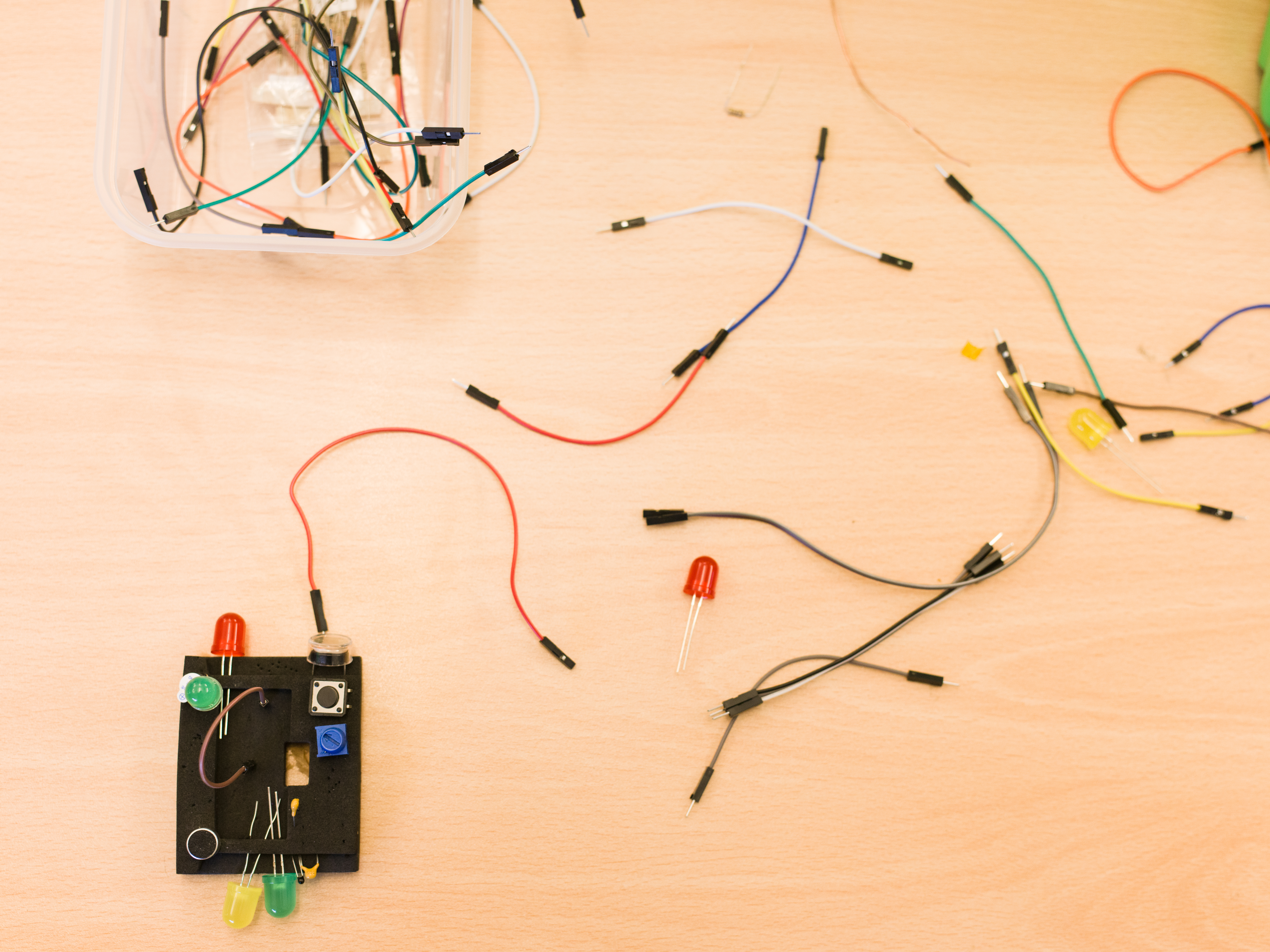Dan Ryder is a teacher at Mt. Blue High School, Maine USA. He’s also a pi-top champion. In this article, he tells us what learning by making has done for his school, and showcases three specific examples of students' work.
Here’s what I’d like to do today. You’re going to learn about how to build a makerspace in your school, in your learning environment, that focuses on problem-solving, deeper thinking, deeper learning. And it doesn’t matter where you are and no matter what the resources are that you have available to you or the barriers that are in front of you.
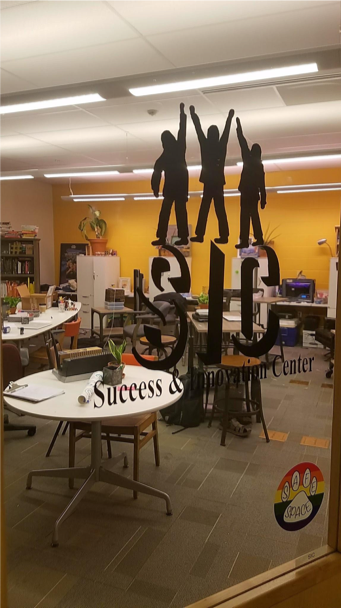
So, this is a picture of my space. This is where I teach. I teach in the western foothills of Farmington, Maine. We have 650 kids and we serve 10 communities. Every day the kids go to school with more people in the high school than in the town they live in. We have a completely integrated tech centre, a career and vocational tech centre, in our school, and it’s been that way for 30 years. After a recent renovation project, we no longer have tech wings and academic wings. All of our labs and classrooms are intertwined. So, you walk down the hallway and you find a welding lab, a social studies classroom, a math classroom, and a composites lab, all lined up together.
The idea is that the kids are experiencing this intertextuality of learning kind of all the time, even if their classes aren’t always collaborating, they’re constantly being inspired by the things around them to be curious and want to know more about the world around them.
We started this thing called The Success & Innovation Centre, and what I want to talk a little bit about is how we got it started and what we’re doing there, and how you might be able to do the same thing in your spaces. And the types of learning that we’re doing align with what your missions are but also align with what pi-top is doing with their frameworks for learning. And for our space, we took over a faculty lounge (staffroom). We said, ‘we don’t need this faculty lounge, kids’ learning is more important,’ and no one could stop us because the principal said so.
So this was all made possible by a GEAR UP grant. If you’re familiar with GEAR UP, their focus is on post-secondary aspirations, and trying to get students starting in elementary all the way up through to seniors, to have a goal in mind for what they’re going to do next with their lives after they’re done with their formal education, and that that might take a lot of different looks.
And one of the things they gave us was some money to see if there was a way we could figure out a way to do that through multiple pathway support. To get people, and kids, different ways to go about achieving that, than what it means. It was designed by a group of people including myself and my co-director Becky Dennison. At the heart of our space, we’re fuelled by design thinking and restorative practices. We love restorative justice in the SIC. We love human-centered, empathy-fuelled problem-solving at the SIC and we fuse together STEAM, STEM and social work in our space. Everything is about the people and need-finding. That’s what we’re really trying to do. We’re trying to solve problems, and we’re trying to figure out what the actual need is, and teach kids to have agency in determining what those needs are for themselves.
A typical day in the Success & Innovation centre
Here’s a typical hour; at eight o’clock in the morning a kid walks in and doesn’t know where they’re going to sleep the next night and we help them find a place where going to sleep, and where they’re going to stay, and how they’re going to problem-solve and stay safe, and then 15 minutes later I’m helping a kid build a windmill for his social studies class and his science class because he doesn’t do great in school and he needs to figure out a way to combine the standards into making one thing, instead of making two things, because we can only get one project out of him, but we’re probably not going to get two. Then at 8.30, another kid walks in who’s not going to graduate. We help her figure out how to pass her classes, and then 15 minutes after that, a kid walks in and we are figuring out how he might be able to self-publish his novel. So that’s what like a normal morning looks like!
In our SIC, everybody can access the space, any kid can come in. You don’t sign up for a class to do it, you don’t have to be part of a program, you don’t have to meet some sort of a threshold. If you’re a student at Mount Blue campus, or you’re a student of one of our sending schools that’s sending kids to our vocational program, you can walk in the door and get help. And we often get asked if we’d help with middle schoolers. If they showed up, we would help them too. And we’ve actually had kindergarten classrooms come in and work in our space. Just because they want the kids to get excited about the high school and see it as not scary, but also we have cool stuff that they can, you know, mess around with and do some interesting things with.
No more dumpster projects
So this idea of 'no more dumpster projects' is that we make so many things that we just throw away. That after we build it, we make it for class, we get a grade on it, and it just goes ‘poof.’ We never see it again, right? And if you look at the pi-top frameworks for learning, what you’re going to see as a thread through all of that situated, contextual, interpretive, challenging, bounded, adaptable, research-driven, collaborative, project-based, and reflective. You look at those 10 postures for learning, and what you’re seeing are skills that you need for later, and you see yourself oriented to doing things that matter. Things that have a life beyond the assignment. Life beyond the standards. Right?
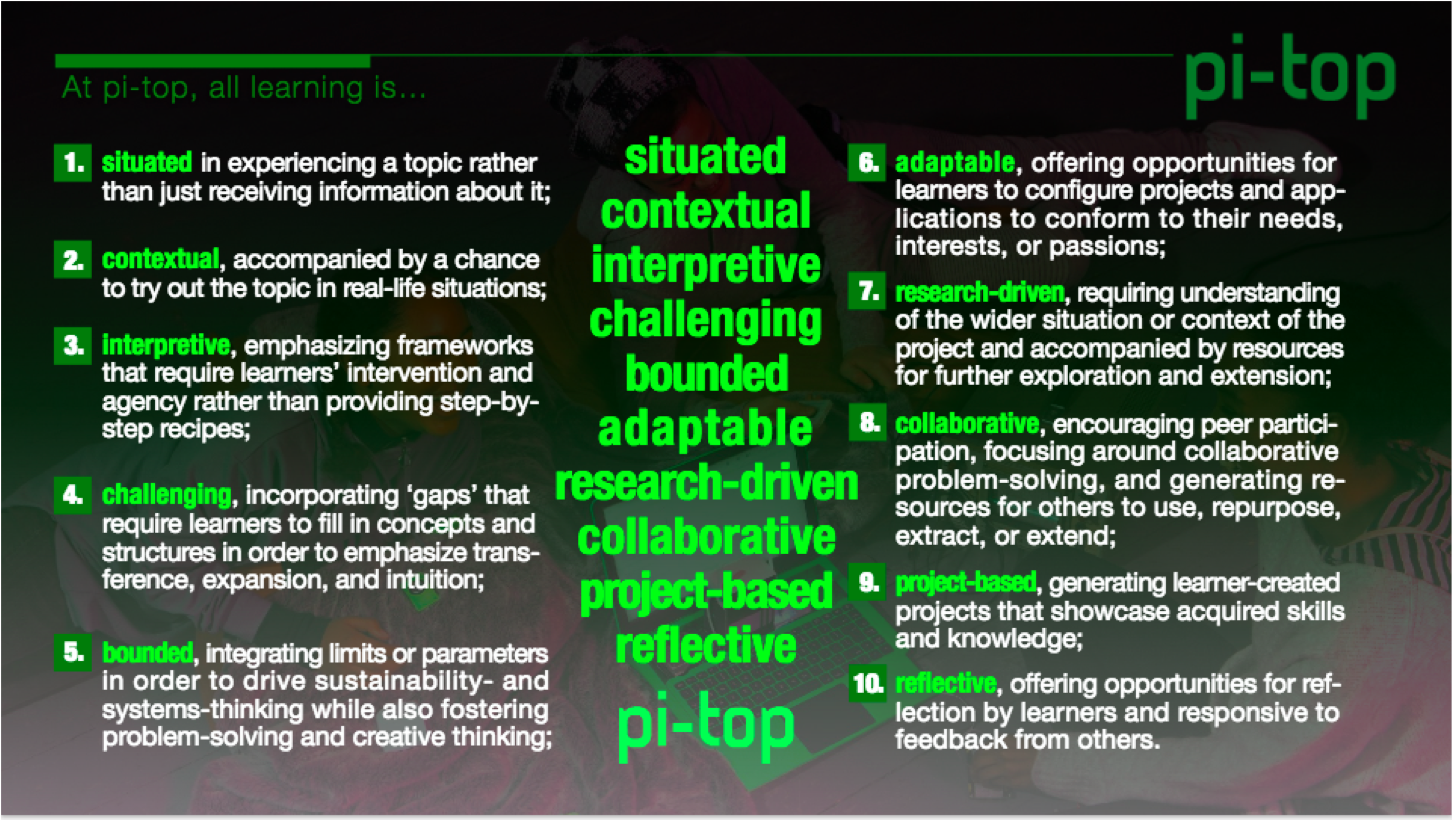
There isn’t one thing up there that you don’t want kids well-versed in, that you don’t want them building capacities in, or doing the types of thinking that we want. I mean does anyone really want kids not being interpretive? But we create environments that lead us to that all the time, usually because we’re not even aware that this is what we’re doing.
So these are three projects I’m going to share quickly, and I want you to be thinking about – this is really important – none of these three projects involve pi-top. None of them involve using coding, most of them don’t even involve using a deep technology piece. But I want you to think about how they could, and how we might be able to elevate that based on pi-top. How we might take any one of these three projects that we’re about to see and take them to the next level with some of the tools you see in front of you.
The table
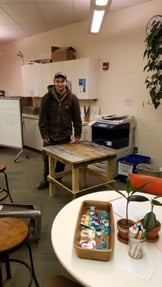
This is Michael. Michael is this amazing kid who struggles in high school. The environment of high school does not play nice to him. He freely admits it, he freely owns it, but Michael loves ATVs (all-terrain vehicles). He loves building, he loves trucks, he loves ice fishing. He does not love English class. He doesn’t love academic learning for the most part, but he loves learning things. He is super-curious, and he is a very articulate dude. So, Michael had to pass his English class. His grandmother was going to kill him if he didn't and he was going nuts.
Michael came to me and he goes, ‘I don’t know what I’m going to do. Can you just help me write my paper?’ I’m like, ‘why do you want to write a paper, like, she said that you could do anything?’ ‘I don’t know, it was just the easiest thing. The easiest thing to do is write a paper.’ I’m like, ‘no no no no no no, what do you like doing?’
So, we sat down and I said, ‘what are you passionate about?’ He said he likes to build stuff, right? So, he’s passionate about building. ‘What else do you like?’ ‘I like…I like…like carpentry, and I like these things.’ I was like ‘cool, so what would you build? If you could build anything, what would you build?’
And he goes, ‘I’d build furniture. I’ve never built furniture before.’ I was like ‘awesome. I happen to know that the social worker upstairs needs a new table.’ So, what if he built a table for the social worker? He’s like, ‘I don’t get this, how’s this supposed to help with my English class?’ and I was like ‘woah, hold on, easy tiger’, right? Because what he had to do for his English class, is he had to connect two of the books that they had read thematically, and he had to tie them into the hero’s journey. And he had to tie them into a film he liked. He loves the Fast and the Furious, and so he figured out how to connect the characters of Catcher in the Rye, and Fast and the Furious, and I Am the Messenger by Markus Zusak.
He combined all those things together and he built a metaphorical table. Built to the specifications from the social studies teacher. Went and did an empathy interview, figured out what it’s like to sit in his office, saw the real space, had a conversation about what that really means, what it’s going to be like to sit there and work with it.
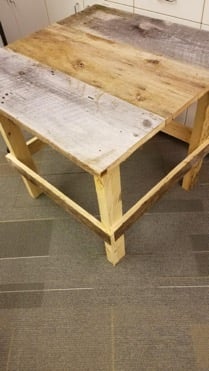
Then he said, ‘oh I don’t know how I’m going to get money for this.’ And I said, do you have to spend money on it?’ He goes, ‘wait! I took down a barn last summer.’ So he went next door and he grabbed all reclaimed wood from next door. At the end of it, he was so proud of it, he goes, ‘I’ve got about 25 cents in this thing!’ Because it was also made with reclaimed barn nails. The whole thing.
But what you can’t see here is what he did next, is he went through and he came up with six quotes that he thinks are important things for kids to understand about heroism, and to be a hero, and the heroic journey. And then he wood-burned them into the table... backwards. And he like looked at them in a mirror and then reversed it. So when you look at it, it just looks like gibberish, but you can kind of tell it’s letters, right? So if a kid takes a mirror and holds it up to it, and then looks at it and realises it’s backwards on top of that, they can actually figure out what it says.
So the social worker can use it as a problem-solving riddle in his classroom. And then what they’re reading are things like, ‘anyone can be a hero,’ or ‘you have the ability to change your own life’. These are the things he put on the side of this thing. And this is a kid who was seriously like, ‘uhhhhhh…’ I don’t know’ on a Tuesday, and then the next week he’s sharing that with all the gubernatorial candidates running for Governor in the state of Maine because they came and visited us in the SIC.
So that’s just one example of the type of learning that we’re doing. But the idea is to make something real, not a dumpster project. He met all the standards for English, he went and recorded a video and explained how all of that shows everything that he needs to know for the standards so there was no what we like to call ‘dumbing down’, right? ‘Oh, you’re doing a hands-on project so now I guess we’re not going to do the real academic things now.’ No no no no no, we can do this, and we all have the capacities, no matter where we are, to use reclaimed materials to solve a problem for somebody in your school. Any school can be doing this, right? It doesn’t cost anything.
The dance
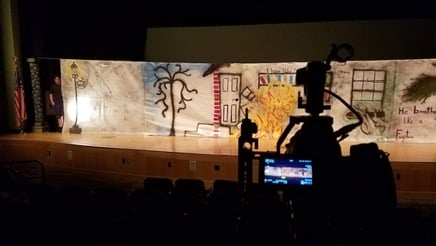
So, the dance. A student in an honours English class, admittedly a pretty strong student, collaborated with someone else in her class who’s in an art class, and they created a choreographed dance to The Book Thief (we’re big Markus Zusak fans in the western hills of Maine!). Why I’m including this is, if you see here, that’s from her digital media class. We helped her connect to all the different programs on campus that could help her to make the thing she wanted to make.
We connected her to the art teacher, and she already knew the art teacher but she was afraid to ask the art teachers about like getting lots of material. So we went and got her lots of material. We filmed this on the Friday of Memorial Day weekend, in the evening. This was when she made it because this was when the space was available. I went and unlocked the space for her and she and her family and all these other kids that she got together to help her with this thing. But it was this true collaboration, true collaborative spirit to make this thing happen. And it’s absolutely gorgeous and we were showing it earlier, the actual video. They went through and they took the soundtrack from The Book Thief, remixed it, cut it down, put it into their own and it’s an original dance with backlighting that came from the digital media class as well, they understood how to do lighting. The two kids that are our techs that run our theatre were there. They learned how to do all kinds of stuff. So there’s this ongoing learning experience happening all the way through it.
The sword
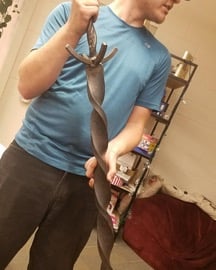
And finally, the sword. And this one is just like a personal favorite, because a kid made a sword, and I think that’s cool. This is Tyler. Tyler’s one of our other regulars in the SIC, and Tyler started as a welding student in the fall. Ok, he already knew about welding. His dad’s a welder, and he’s been waiting his whole high school career to get to this point where he could do it, but he was paid $250 to make this replica of a sword from a game called Dark Souls. And he got paid to make the replica. He taught himself how to do that corkscrewing. He taught himself how to do that with the tutelage of his welding instructor.
The reason I include this in our story is because every day Tyler would come in and meet with us and work with us in some way or capacity. We were able to help him realise that if he wants to start a business while he’s in high school and have another income stream, he can. He goes, ‘oh, I can? Yeah. You mean I could just make a Facebook page?’ I’m like, ‘yeah. Now you can’t do it at school because it’s locked down, but when you get home…’
Next day, he’s online. He comes in and he goes, ‘hey I made a Facebook page.’ I was like, ‘cool, what’s the name of it?’ I can get on Facebook at school, so I went on and I connected my friends, and he walks in two minutes later and goes, ‘dude, I have 180 likes.’ I go, ‘yeah, that’s what happens because I’m popular…’ But I shared it out and I showed him the power of amplification, how just getting a couple of people to connect to what you’re doing, right. Well, next thing you know, he’s got five different commission jobs, and this student created an income stream for himself doing custom artisan metal fabrication. So he’s making roses, he’s making little placards, he’s making swords, he even made Thor's hammer.
So those three stories – we go back to that framework from pi-top, right. I think you can see the situation. We’re in experience, right? We’re not just like throwing stuff at you, right, these kids are doing things that are contextual, interpreting information. It’s challenging, right. I like ‘bounded’. I’m a big believer in creative constraints, right.
One of the worst things we do to kids, and we do it all the time and don’t realise we’re doing it, is we say, ‘do whatever you want’. That’s the fastest way to set them into atrophy. They just don’t know what to do. They crave it, ok, they’re adaptable but we can change anything that they’re making. It’s research-driven – you have to find out how things work and you have to research. Yes, research is looking things up in books and in articles, but research is also asking people, and finding out experiences, and talking to experts and digging in deep that way, as well as working with more than one person.
This article is an abridged transcript of a presentation given at ISTE2018. Dan Ryder is a teacher at Mt. Blue High School, Maine USA. He’s also a pi-top champion.
If you’d like to find out more about how 'learning by making’ with pi-top can help you, your students and your school, get in touch here.
